Wellington, Fla.—Dec. 30
There’s an elusive moment all dressage riders are searching for when they swing into the saddle. A space within the movement where their horse is producing as animated and perfect a gait as he can without slipping from the extended trot to the canter, from the piaffe to jigging backwards—the tipping point.
On the final day of the Robert Dover Horsemastership clinic, trainers Dover, Debbie McDonald and Michael Barisone encouraged their riders to boldly fall to the wrong side of that tipping point—they invited their riders to make the mistake.
“If you don’t try it, you’ll never trust it,” McDonald told a student worried her horse would break to the trot if she collected anymore. She explained that if a rider doesn’t push to find the upper and lower limits of their horse’s collection and extension while schooling—the point where they break into the trot or up into a canter—then they’ll never know when to keep pushing the horse and trust them not to break at a show.
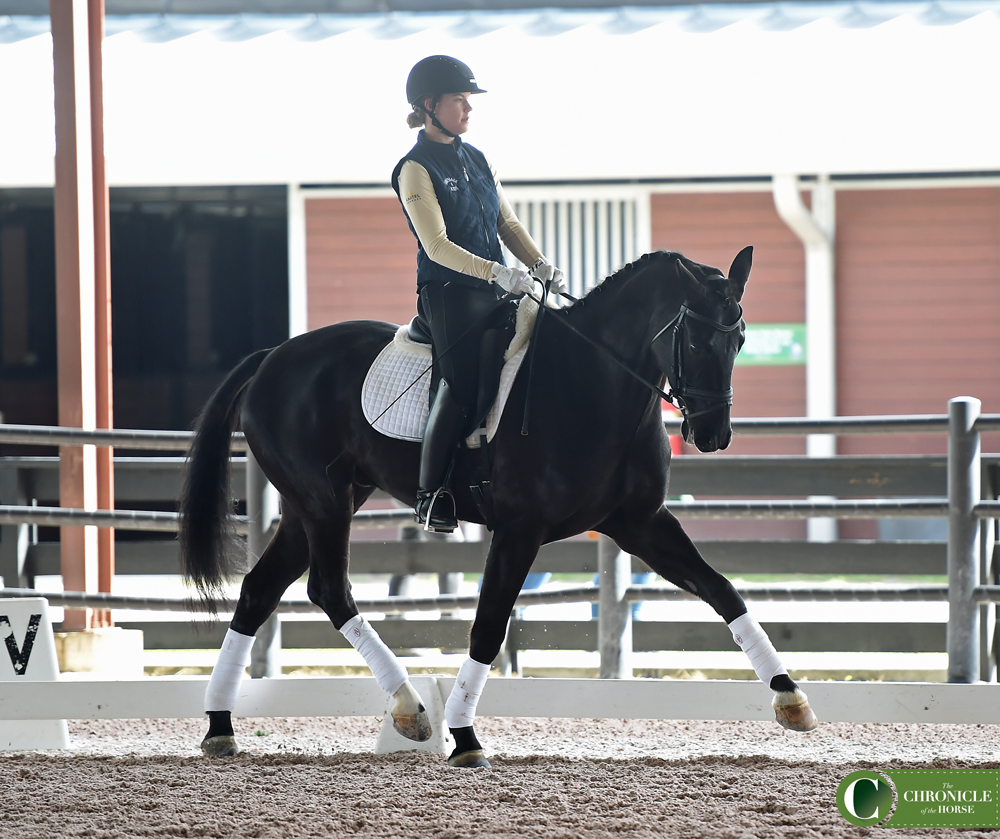
Callie Jones showed off her horse in a lesson with Michael Barisone. Photo by Ann Glavan.
“You have to find the access point of the canter, don’t be afraid of breaking,” Dover directed one student struggling to push the limits of her pony’s collection. “If he breaks you say ‘Mama said wake up!’ and you wake him up.”
Barisone insisted one of his students continue asking her horse into a more forward marching walk, even as the horse broke over and over again into the trot. While it may be frustrating to repeatedly fail an exercise at home, better that than in the ring.
“Shows are stressful,” Barisone said. “So we have to put some pressure on you at home.”
To The Left: Do The Dre-sage Slide
Who doesn’t love some good lateral work practice? All three trainers reminded their students of some of the finer points and details within the work to improve their results.
McDonald, for example, emphasized the importance of picking a place in the arena to put your eye on and move toward.
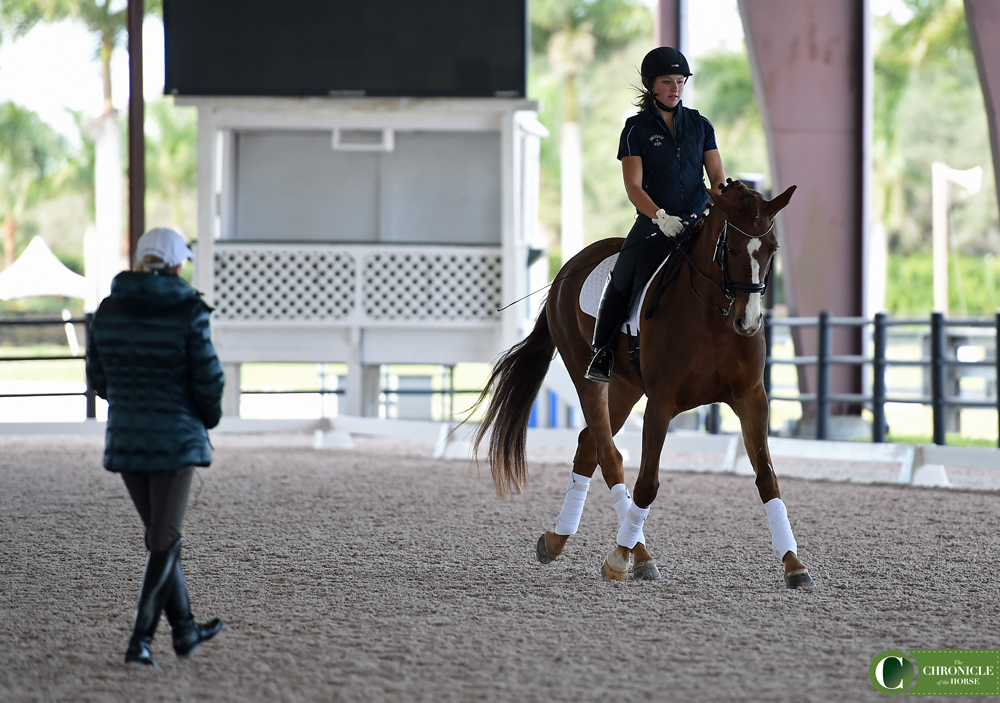
Rebekah Mingari gets put through her lateral work paces by Debbie McDonald. Photo by Ann Glavan.
“Always give him a place to go, if I just start here and say, ‘go sideways,’ the horse has nowhere to go,” McDonald said. “He needs to be able to go forward somewhere.
“Forward is the key,” McDonald continued. “Sideways is easy, and forward and sideways is lovely, but forward is always more important.”
Barisone echoed McDonald’s prioritization of the forward movement.
“When you do a shoulder-in the horse should be flying forward not slowing down. A lot of people think they should be less forward in the lateral work when actually it’s an opportunity to get even more out of the horse.”
No Sleeping In
The Horsemastership clinic was no place for a lazy dressage horse—any animal behind the leg or lacking forward impulsion got a firm slap of the calf to send it forward. All three trainers were adamant about that.
“There is no begging in dressage,” Barisone said to one of his students. “We ask, we tell and then we demand. You shouldn’t be saying, ‘leg, go forward, leg, go forward,’ every step.”
“You’re always a half-halt away from perfect,” Dover said to Hannah Irons as he had her work on collecting her pony and getting him rounder.
ADVERTISEMENT
Dover had Irons collect the canter as if she wanted to canter in place to improve the quality of the canter overall, and he insisted she not feel like she had to clamp her leg down constantly to maintain the canter.
“Take your feet away from his sides, is he still cantering?” Dover asked. “He thinks he only goes if you keep your leg on and that’s not right, use your seat and rein and very little leg to collect him here, don’t just hold your leg on.”
“To be an international level grand prix horse, a horse needs three things,” Barisone continued. “They need to accept pressure, they need to accept criticism, and they need to be forgiving.
“You’re a great student, you say right away when I tell you to do something ‘OK, I’ll try,’” Barisone told student Jessica Fan. “That will get you so far, so far.”
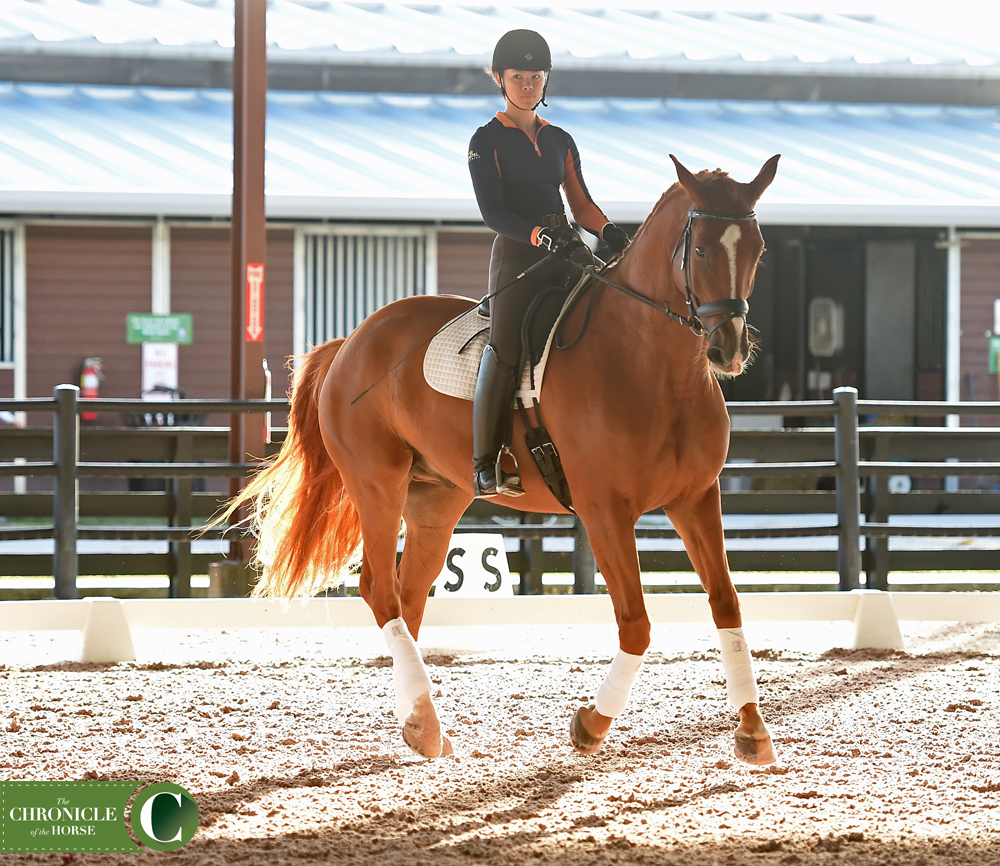
Jessica Fan riding her horse Woohoo in a lesson with Michael Barisone. Photo by Ann Glavan.
It was a brisk day in southern Florida when the clinic began at 8 a.m. with temperatures falling to 55 degrees after a balmy 80 the previous day. This made for some extra bright eyes and bushy tails coming out of the barn for the day’s sessions, and McDonald welcomed the surplus energy.
“Fresh is good, I love that,” McDonald told a student after her horse tossed her head and shoulders a bit warming up. “You just have to get them to focus and channel that energy!”
“That is one thing people don’t practice enough, how to ride into corners and coming out of them,” McDonald said. “The horse has to stay with you through that.”
A Saddle Isn’t A Rocking Chair
They say you can’t pour from an empty cup—translated to equestrian speak, it’s very hard to help out your horse if you aren’t squared away with your own body position.
“You do not move your back or pump your seat to make the horse go. If he gets behind you, you don’t do the hula with your body. You leave your body in the same place and you slap him with your calf. I don’t want you to be rigid, but I want you to be still,” said Barisone.
Barisone emphasized multiple times that he didn’t want riders to be stiff as boards, but rather very resolute about where they wanted their position to be.
“An average rider adjusts themselves to where the horse wants them to be, and expert rider adjusts the horse to where they want them to be,” Barisone said.
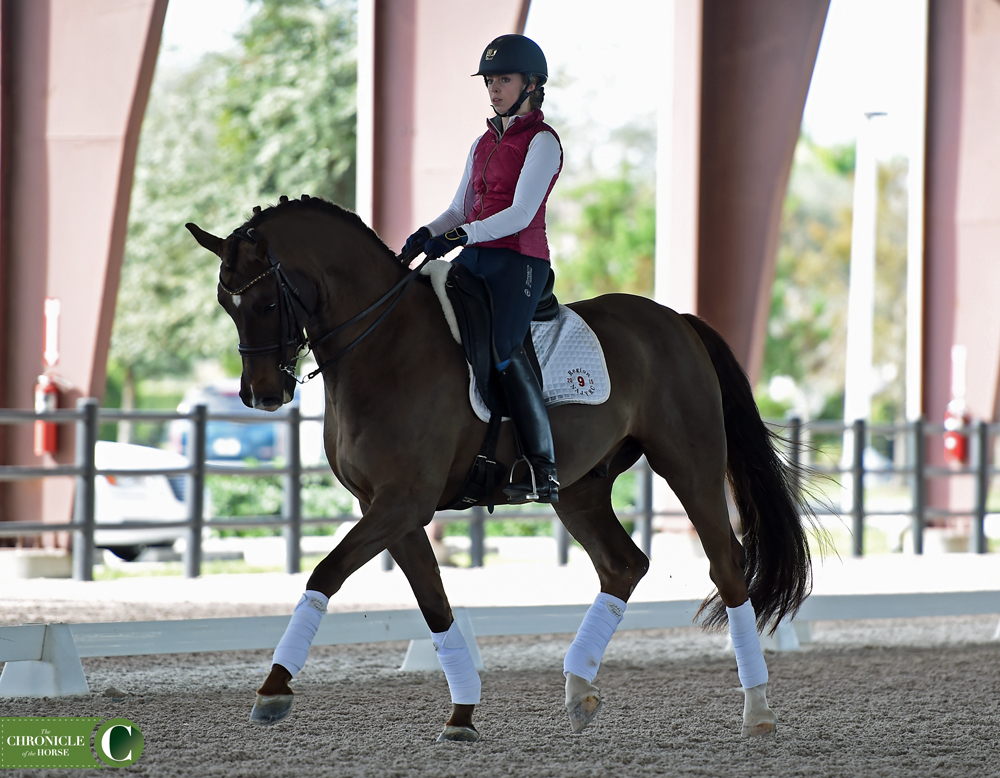
Alison Hopkins had excellent body position in her lesson with Dover during Friday’s clinic. Photo by Ann Glavan.
Barisone seems to have an analogy for everything, and this was no exception.
“If you’re moving all over the place the horse gets flat and stops moving,” Barisone said. “It’s like if I’m an archer, I’m standing on a platform, and I draw back the string on the bow and sight the target. Then someone comes along and shakes the platform—I can’t hit the target.”
After helping correct a rider’s weak side in her position and her horse’s resulting faults, McDonald asked if she had ever considered doing Pilates.
“You’re never too young to start building core and separating your arms from your legs and that sort of thing,” McDonald said. “Because you can get a lot out of this horse but not if your body isn’t in the correct place.”
Dover also encouraged a student in his lessons to fight through fatigue in an exercise where her horse was getting heavy and resisting her efforts to collect him up. Each day of the clinic begins with a fitness session at 7 a.m. with football player Mike Barthelemy, and NFL player Sammuel Lamur attended one morning to show riders some different exercises he does to stay fit.
If Your Horse Would Rather Throw It In Reverse Than Really Collect….
ADVERTISEMENT
Dover spent a lot of time working with rider Lexy Donaldson and a horse she was catch-riding on a small circle around him at the far end of the arena. When Donaldson would try and collect the horse in the canter or keep the horse in the connection from the walk to the canter, the horse stopped and threw his head up.
To address the issue, Dover worked with Donaldson on the volume and timing of her aids—the idea was that instead of shouting at the horse to get back in the canter, Donaldson would coax and tickle the horse into the canter with a delicate aid that immediately gave when it got the response she wanted.
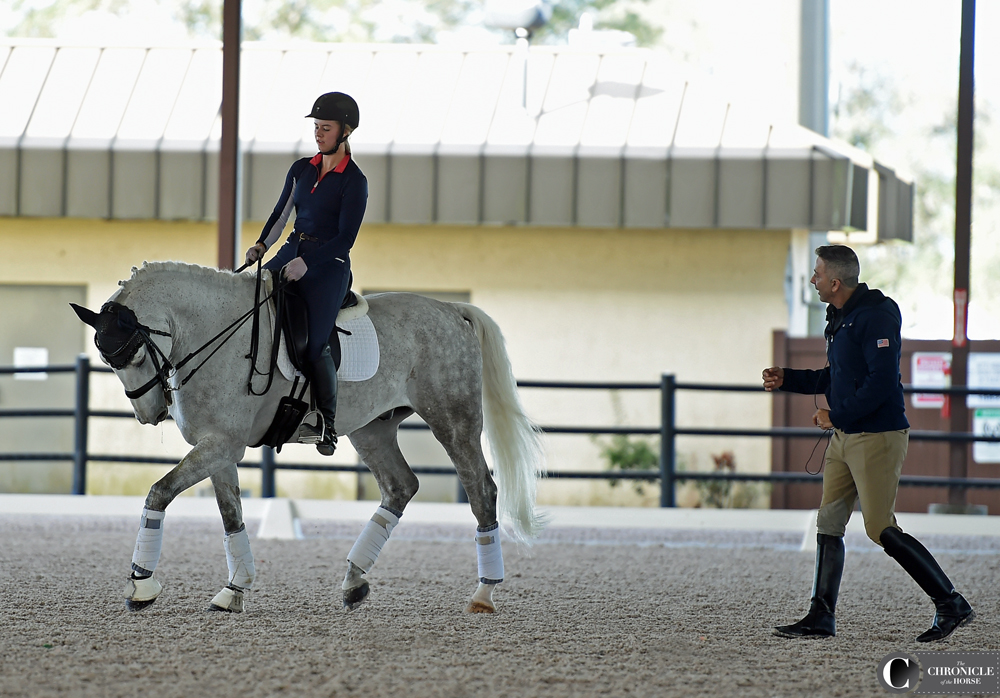
Dover helped rider Lexy Donaldson get the horse she was riding lighter in the contact and moving forward honestly. Photo by Ann Glavan.
“This horse is good for you, this is like sensitivity training!” Dover said with a laugh. The gelding was indeed very sensitive, and responded well to Dover’s instructions to ask for the canter with textbook light aids and reward the horse immediately when he responded.
This particular horse was also quite heavy in Donaldson’s hand, so Dover had her work on encouraging him to carry himself.
“Drop the right [rein], drop the left, drop both,” Dover directed, before having Donaldson take a feel and start the process again. At the end of the session, Dover had Donaldson circle and continue feeding rein to the horse until he was trotting nicely and forward on a looser contact.
“There’s a real thing to look to in western riders, how they have the horse collected underneath them on long reins and with tiny cues,” Dover said. “I make my students ride one-handed sometimes.”
“That Horse Needs To Be Bent Like A Croissant!”
Many students came trotting or cantering out of a corner only to be sent spinning back into it by one of the trainers. All three were tough on the execution of the corner (though McDonald surely carried the day with her French culinary corner analogy).
Barisone, for example, insisted that riders put exactly five trot steps in their corner, and if a rider came out of a corner without lining up their diagonal or position on the rail down the long side, you better believe they were going to try it again. McDonald affirmed the importance of the ends of the ring with her students.
“That is one thing people don’t practice enough, how to ride into corners and coming out of them,” McDonald said. “The horse has to stay with you through that.
“That horse needs to be bent like a croissant!” McDonald called out to another student as she came through a corner.
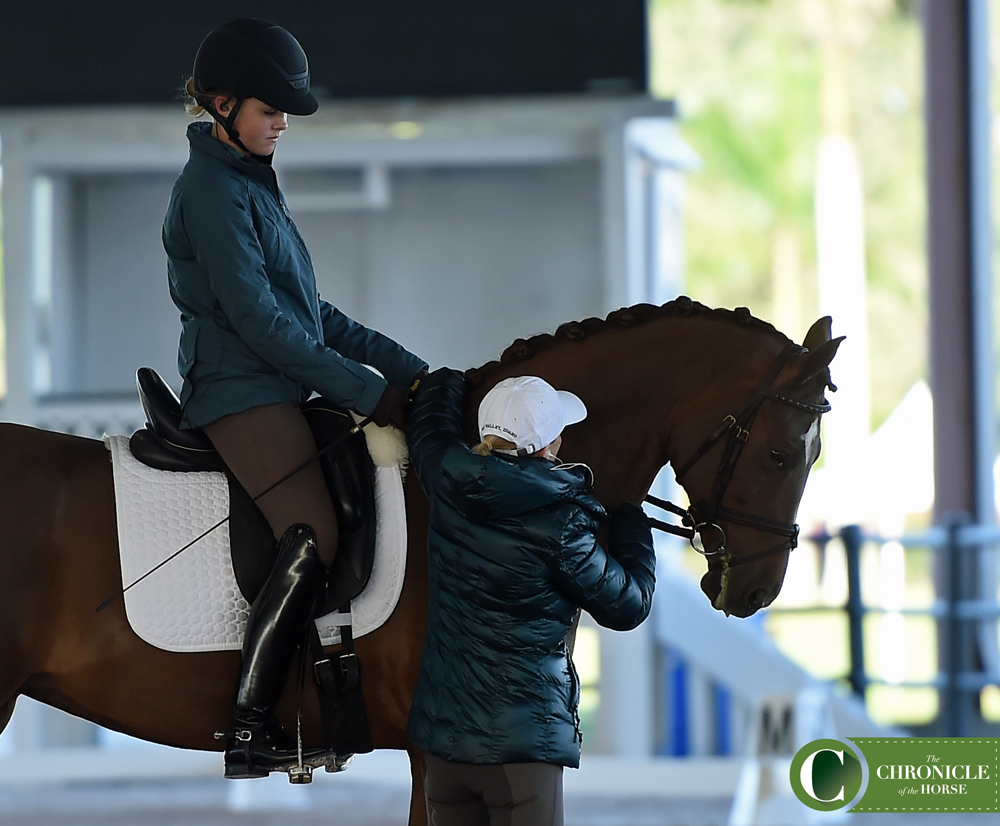
Debbie McDonald shows rider Julia Barton how she wants her to exceute a rein aid during a lesson. Photo by Ann Glavan.
Dover had a number of his riders collect the canter and “canter on the spot” in their corners before heading out on the diagonal or long side to school a particular movement, like the pirouette.
“When you go into the corner, you find out if you’re going to have the pirouette in the middle of the ring,” Dover said. “Your canter in that corner tells you, canter on the spot in that corner to do that pirouette later.”
Also see “Robert Dover Has A Vision For Riders At Horsemastership Clinic” for more of COTH’s coverage of this clinic.
Click here for a clinic schedule and list of riders competing, and don’t forget to check out the Jan. 23 issue of the Chronicle for more on Robert Dover’s Horsemastership clinic!














